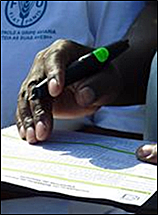It began in southern Africa in 2007, when Philip Fong, FAO‘s Regional Data and Information Officer in Nairobi, Kenya turned to technology to help African countries cope with livestock diseases.
What he found was that existing disease information and surveillance systems were inadequate. Officers in the field were unable to get their collected data to decision makers fast enough to move quickly against the reported disease.
Most organizations that deal with health – whether they focus on human, animal or plant health – recognize the need for continuous monitoring, accurate diagnosis and rapid response as a cornerstone for combating the spread of infectious disease.
Under the old system, data collectors reported their findings to their district office, which then sent the information to the provincial office. The provincial office then would cable the data to headquarters, where the decision to act would be made.
“We did sort of a timeline on how long it would take for actual data to … get to headquarters to be able to make some of the decisions,” Fong said. “It could be as much as 2-3 months.”
Fong says a quick response typically came after a person “would get on the phone and get some anecdotal information to the district vet or the regional vet,” so that someone could be dispatched to do more investigation.
Field workers were further burdened with trying to provide as much information as possible without proper tools.
There had to be a better way. And Fong found it in a pen – but not just any pen.

Philip Fong, FAO’s Regional Data and Information Officer in Nairobi, trains vet assistants in Kenya on animal disease reporting using digital pen technology. (P. Fong)
This was a digital, GPS-enabled device that captures information, connects to a phone via Bluetooth, and uploads information to remote servers in real time.
People in the field “captured information in a structured format using a disease information form that we created that met all the requirements of the information system,” said Fong.
Field workers still used paper to record information with the digital pen. But they then connected their mobile phones to the pen via Bluetooth. “Then the phone would connect onto the mobile system and send that information to a central server,” added Fong.
“What it would do is send individual case record information directly to a centralized server, which then would be accessible by many levels,” he said. “So the district people would be able to see it, the provincial and the national people would be seeing it all at the same time as it comes in.”
Based on the incoming information, an assessment would be made as to the severity or type of detected disease and a response would follow.
This approach, says Fong, enables decision makers to “monitor exactly what they [i.e., field workers] are doing because the phone has GPS connectivity.
“We were able to know where they were,” he explained. “We know exactly what time the information was sent in and how many forms that each individual sent in because each individual digital pen has a unique serial number” assigned to each person.
That might sound a bit creepy. But field workers were receptive to the technology.
“It was actually a different reverse type of psychology in the fact that people felt empowered because the information that they were collecting was not going to be massaged and put into sort of summary tables, but the actual head of the department at headquarters could actually see the work that they are doing,” he said.
The collected information is detailed enough to allow decision makers to understand what data collectors are seeing. “We are seeing the types of diagnosis they are making,” which allows for capacity training, as needed, or retraining of individual staffers on disease surveillance and diagnosis.
So what does all this cost? Fong says existing money used for data collection, capture and processing could be used for this technology instead.That entailed outsourcing the server side of the business and information processing to the private sector in order to support and maintain the system.
“That was the model that was used in southern Africa. And from what I gathered, there were …. 6-7 countries that are still using that same model,” he said.
The digital pen, piloted in 2008 in six countries, continues to be in use and has since changed the way livestock disease is detected and diagnosed in many African countries.
